The coming 2013 according to the Chinese calendar will be the year of the snake. In order for the year to be successful, it is customary to acquire a corresponding symbol in advance. Who said that it must necessarily be a statue or an image of a creeping creature? It seems to us that a live mascot is quite suitable for this purpose - no, no, not a python in a bedroom with a safe, although for some this option is also relevant. For flower growers and gardeners who are not burdened with unnecessary property, we will select a "snake" plant. So, let's investigate the question, what kind of candidates can be for this role.
In fact, it turns out that there are only two such "official" plants recognized by the botanical nomenclature, the rest are the fruits of human associations, phobias and folklore. The most indisputable among them is the Moldavian snakehead (Dracocephalum moldavicum), the shape of its azure flowers resembles the head of a snake.
 |  |
For a long time, scientists have been singing praises for its beneficial properties, and breeders have offered winter-hardy and at the same time beautiful varieties, but outside of their native Moldova, this spicy-aromatic plant is still little known. Maybe the time has come to try his "lemon" greens in the kitchen, in medicinal preparations and teas? For lovers of herbal medicine, this is just a find, from many ailments. Perhaps only those who are constantly on diets will not be delighted with him - the snakehead is able to significantly increase the appetite. Well, you don't want either inside or outside - just admire it in the garden - you will see how many butterflies and bees will flock to the feast when this unpretentious fragrant plant blooms. Or you can grow it on the windowsill. In general, buy seeds for yourself and a couple of bags each - as a gift for friendly gardeners.
The second plant is no less healing, and even more recognized by official medicine. This is a serpentine mountaineer, he is a large serpentine, or meadow, or European (Polygonum bistorta syn. Persicaria bistorta). It is also called Cancer necks, for the similarity and they are thick and short, serpentine curved and slightly flattened dark red rhizomes with folds on the surface. A common plant of the European part of Russia, it starts up its rhizomes mainly where reptiles like to live - in wet meadows and swamps, where it is damp and warm.
Until recently, an unremarkable weed sown in the fields, now it is a very popular plant for decorating wet shores of reservoirs. The more lush and vibrant varieties are great for mixborders, in which the pink or reddish inflorescences of the plant spike densely from the end of May for almost two months. However, as far as planting material is concerned, it is easier to take it from nature (seeds or rhizomes) than to find it commercially.
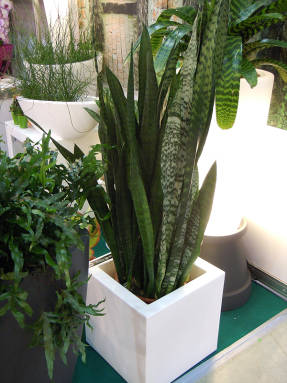
You can also pick up something from indoor plants. First of all, it is sansevieria, or three-lane sansevieria
(Sansevieria trifasciata), in our everyday life - the mother-in-law's language, the British - the Serpentine plant, and the Americans - the Serpentine skin. Moire irregular transverse stripes on leathery leaves really remind her very much. It would not be an exaggeration to say that this African plant, which recently seemed rustic and boring, is now experiencing an active renaissance. Not only due to the fact that it is extremely unpretentious and can do without watering for a long time, which is very important when we plunge into the bowels of the Internet and forget about everything, but also due to the emergence of various new varieties that can become a stylish interior decoration. And, in addition, three-lane sansevieria was recognized by researchers as a plant that most effectively cleans the air of our homes filled with plastics and chipboard from organic pollutants, in particular, formaldehydes.

The name snake-tree, or snake-palm, refers to a plant called amorphophallus cognac
(Amorphophallus konjac) aroid family
(Araceae). It is from East Asia (China, Vietnam, Thailand, the Philippines), and biologically very interesting.From the tuber, the plant produces a single leaf, which has its "umbrella" plate. Actually, the leaf petiole, all covered with merging greenish-black spots on a dirty white-pink background, is associated with a snake. The impression is enhanced by scattered point warts at the base. Amorphophallus blooms very rarely and only for one day, revealing a dirty purple veil and exposing a vertical ear of the same color. But its short-term flowering cannot go unnoticed due to the strong smell of rotten meat, which exudes a large flower, counting on attracting pollinating insects. It is also used as a forcing plant, kept in the garden in the summer, and brought indoors for the winter. Tubers can be found on sale in the spring. After planting, they first put forward a peduncle, and after flowering - a lonely leaf. In autumn, the aboveground part dies off and a dormant period begins for the plant. Flowering is not always achieved, therefore amorphophallus is more classified as decorative leafy curiosities. But, judging by our forum, many are already growing it. The name of a rare genus of plants in our country, Ophiopogon
(Ophiopogon), derived from Latin
ophis - snake and
pogon - a beard and is the Latin translation of the local Japanese name, which sounds like "Snake Beard". The look of beards has bunches of arcuate curved belt-like leaves, forming very beautiful fountain-like curtains. By the way, the plant also has a more poetic name - lily of the valley, given for drooping bell-shaped flowers that rise low above the foliage in brushes or panicles. They are evergreens native to the warm temperate and tropical regions of East, Southeast and South Asia. One of the species - Ophiopogon flat-shot
(Ophiopogon planiscapus) winter-hardy up to -29 degrees, so it can be grown in the southern regions, and with shelter - in central Russia, but only persistent gardeners can do this.
Basically, ophiopogons are more suitable for winter gardens, where they can grow in pots or in a ground cover crop in the ground. You can also grow them on the windowsill, if it is possible to reduce the temperature of the content in winter to + 10 + 15 ° C. Grown indoors, basically, two types - Japanese ophiopogon, or Japanese lily of the valley (Ophiopogon japonicus) and ofiopogon yaburan (Ophiopogon jaburan) - more often their compact and variegated varieties, and not natural forms. Ophiopogons can be used in many ways - for the winter to be taken out to the garden or on the balcony, included in container compositions (they are quite drought-resistant, although they like a good supply of moisture). Japanese ophiopogon is a marsh plant that can be grown in a semi-submerged state in a sufficiently warm (above + 15 ° C) aquarium, but it dies after 2-3 months and requires replacement. But in the terrarium and paludarium it belongs. This species is very important in oriental medicine, the raw material for which is the thickened white rhizomes of the plant, which enhance the masculine essence of Yin. By the way, it was from him that the Japanese name "Snake Beard" spread to the whole genus.
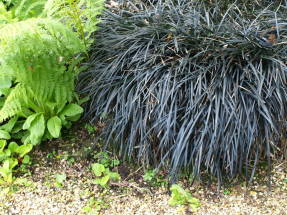 | 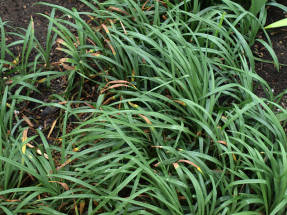 |
Evergreen rauwolfia snake
(Rauwolfia serpentina), can grow well in a greenhouse in a container, but it is not widespread in culture, and in nature it is reduced. It grows in the tropics of India, Myanmar, Indonesia. In ancient times, it was used against snake bites, for which it got its name. There is one more, everyday - the Serpentine root, it is in it that the main healing power of the plant is concentrated. Today it is in demand all over the world as a source of strong alkaloids. You can see this shrub up to 2-3 m in height in Thailand, Sri Lanka or Vietnam, where it is now cultivated. It is easy to recognize it by whorled, rounded leathery leaves, umbellate inflorescences of tubular pinkish flowers with a five-petalled star-shaped limb, and black medium-sized drupes.In Soviet times, they tried to breed this plant on the Black Sea coast, at the Transcaucasian station of medicinal plants in Kobuleti. And in the St. Petersburg Academy of Pharmacy, a method of deep cultivation of the biomass of a rauwolfia tissue culture was developed and patented to obtain alkaloids - first of all, aymaline.
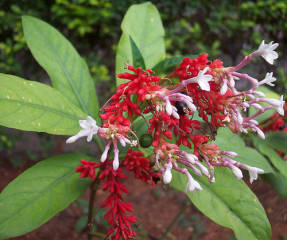 | 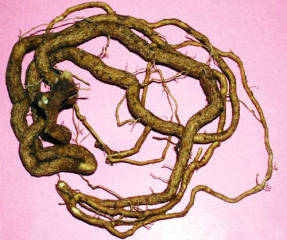 |
Connoisseurs of garden plant textures should pay attention to the group of maples, collectively referred to as snake-bark maple. There are about two dozen of these species in the world, all of them come from East Asia (including the eastern Himalayas and eastern Japan), with the exception of one North American species - the Pennsylvania maple
(Acer pensylvanicum). These are small, usually slow-growing trees 5-15 m high, with varied, beautiful foliage, like any maple. The group got its name for the remarkable bark of the trunks. In youth, it is smooth, but with age it becomes covered with a pattern of vertical dark green or brownish stripes, interspersed with light green, pinkish or white, sometimes with a bluish tinge, cracks. Our Far Eastern species also belong to this group:
In addition to the Maksimovich maple, all other species can be found in separate nurseries.
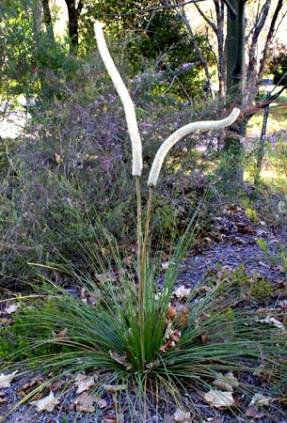
In conclusion, there is another plant that continues the serpentine theme, but for us it is not at all relevant, just for the sake of completeness. It is called the Snake Charmer, and according to botanical nomenclature -
xanthorrhea small(Xanthorrhoea minor). This is an amazing plant of South Australia and Tasmania, also called a herbal, or cereal, tree (Grasstree) for the similarity of the rigid narrow-linear foliage to cereals. Under the ground, a short trunk thickened in caudex is hidden, like the trunks of cycads, covered with the remains of leaf bases, and the shoots form turf with inflorescences up to 0.8-1 m high, foliage and cobs resembling cattails from a distance. The inflorescences are composed of many white or creamy flowers with a lot of nectar. Little birds drink it, and the natives soak flowers in water and get a sweet drink.
Small xanthorrhea grows in peaty wastelands, and sometimes even in swamps. The base of the foliage exudes a large amount of sticky resin, which allows the plant to withstand drought and mechanical stress. There are different opinions about the appearance of the name Snake Charmer - perhaps it was given because of the often intertwining, like a snake, stems, or maybe because this plant serves as a protection for swamp orchids hiding among the stems of xantorrea from eating kangaroos. Although neither the one nor the other version sounds convincing.
Perhaps the very idea of a living snake talisman will not find support in you, but looking at the plant world from the standpoint of ethnobotany is always fascinating. By the way, it turned out that people do not associate it with the world of reptiles very often ...




 You can also pick up something from indoor plants. First of all, it is sansevieria, or three-lane sansevieria (Sansevieria trifasciata), in our everyday life - the mother-in-law's language, the British - the Serpentine plant, and the Americans - the Serpentine skin. Moire irregular transverse stripes on leathery leaves really remind her very much. It would not be an exaggeration to say that this African plant, which recently seemed rustic and boring, is now experiencing an active renaissance. Not only due to the fact that it is extremely unpretentious and can do without watering for a long time, which is very important when we plunge into the bowels of the Internet and forget about everything, but also due to the emergence of various new varieties that can become a stylish interior decoration. And, in addition, three-lane sansevieria was recognized by researchers as a plant that most effectively cleans the air of our homes filled with plastics and chipboard from organic pollutants, in particular, formaldehydes.
You can also pick up something from indoor plants. First of all, it is sansevieria, or three-lane sansevieria (Sansevieria trifasciata), in our everyday life - the mother-in-law's language, the British - the Serpentine plant, and the Americans - the Serpentine skin. Moire irregular transverse stripes on leathery leaves really remind her very much. It would not be an exaggeration to say that this African plant, which recently seemed rustic and boring, is now experiencing an active renaissance. Not only due to the fact that it is extremely unpretentious and can do without watering for a long time, which is very important when we plunge into the bowels of the Internet and forget about everything, but also due to the emergence of various new varieties that can become a stylish interior decoration. And, in addition, three-lane sansevieria was recognized by researchers as a plant that most effectively cleans the air of our homes filled with plastics and chipboard from organic pollutants, in particular, formaldehydes.  The name snake-tree, or snake-palm, refers to a plant called amorphophallus cognac (Amorphophallus konjac) aroid family (Araceae). It is from East Asia (China, Vietnam, Thailand, the Philippines), and biologically very interesting.From the tuber, the plant produces a single leaf, which has its "umbrella" plate. Actually, the leaf petiole, all covered with merging greenish-black spots on a dirty white-pink background, is associated with a snake. The impression is enhanced by scattered point warts at the base. Amorphophallus blooms very rarely and only for one day, revealing a dirty purple veil and exposing a vertical ear of the same color. But its short-term flowering cannot go unnoticed due to the strong smell of rotten meat, which exudes a large flower, counting on attracting pollinating insects. It is also used as a forcing plant, kept in the garden in the summer, and brought indoors for the winter. Tubers can be found on sale in the spring. After planting, they first put forward a peduncle, and after flowering - a lonely leaf. In autumn, the aboveground part dies off and a dormant period begins for the plant. Flowering is not always achieved, therefore amorphophallus is more classified as decorative leafy curiosities. But, judging by our forum, many are already growing it. The name of a rare genus of plants in our country, Ophiopogon (Ophiopogon), derived from Latin ophis - snake and pogon - a beard and is the Latin translation of the local Japanese name, which sounds like "Snake Beard". The look of beards has bunches of arcuate curved belt-like leaves, forming very beautiful fountain-like curtains. By the way, the plant also has a more poetic name - lily of the valley, given for drooping bell-shaped flowers that rise low above the foliage in brushes or panicles. They are evergreens native to the warm temperate and tropical regions of East, Southeast and South Asia. One of the species - Ophiopogon flat-shot (Ophiopogon planiscapus) winter-hardy up to -29 degrees, so it can be grown in the southern regions, and with shelter - in central Russia, but only persistent gardeners can do this.
The name snake-tree, or snake-palm, refers to a plant called amorphophallus cognac (Amorphophallus konjac) aroid family (Araceae). It is from East Asia (China, Vietnam, Thailand, the Philippines), and biologically very interesting.From the tuber, the plant produces a single leaf, which has its "umbrella" plate. Actually, the leaf petiole, all covered with merging greenish-black spots on a dirty white-pink background, is associated with a snake. The impression is enhanced by scattered point warts at the base. Amorphophallus blooms very rarely and only for one day, revealing a dirty purple veil and exposing a vertical ear of the same color. But its short-term flowering cannot go unnoticed due to the strong smell of rotten meat, which exudes a large flower, counting on attracting pollinating insects. It is also used as a forcing plant, kept in the garden in the summer, and brought indoors for the winter. Tubers can be found on sale in the spring. After planting, they first put forward a peduncle, and after flowering - a lonely leaf. In autumn, the aboveground part dies off and a dormant period begins for the plant. Flowering is not always achieved, therefore amorphophallus is more classified as decorative leafy curiosities. But, judging by our forum, many are already growing it. The name of a rare genus of plants in our country, Ophiopogon (Ophiopogon), derived from Latin ophis - snake and pogon - a beard and is the Latin translation of the local Japanese name, which sounds like "Snake Beard". The look of beards has bunches of arcuate curved belt-like leaves, forming very beautiful fountain-like curtains. By the way, the plant also has a more poetic name - lily of the valley, given for drooping bell-shaped flowers that rise low above the foliage in brushes or panicles. They are evergreens native to the warm temperate and tropical regions of East, Southeast and South Asia. One of the species - Ophiopogon flat-shot (Ophiopogon planiscapus) winter-hardy up to -29 degrees, so it can be grown in the southern regions, and with shelter - in central Russia, but only persistent gardeners can do this.











 In conclusion, there is another plant that continues the serpentine theme, but for us it is not at all relevant, just for the sake of completeness. It is called the Snake Charmer, and according to botanical nomenclature - xanthorrhea small(Xanthorrhoea minor). This is an amazing plant of South Australia and Tasmania, also called a herbal, or cereal, tree (Grasstree) for the similarity of the rigid narrow-linear foliage to cereals. Under the ground, a short trunk thickened in caudex is hidden, like the trunks of cycads, covered with the remains of leaf bases, and the shoots form turf with inflorescences up to 0.8-1 m high, foliage and cobs resembling cattails from a distance. The inflorescences are composed of many white or creamy flowers with a lot of nectar. Little birds drink it, and the natives soak flowers in water and get a sweet drink.
In conclusion, there is another plant that continues the serpentine theme, but for us it is not at all relevant, just for the sake of completeness. It is called the Snake Charmer, and according to botanical nomenclature - xanthorrhea small(Xanthorrhoea minor). This is an amazing plant of South Australia and Tasmania, also called a herbal, or cereal, tree (Grasstree) for the similarity of the rigid narrow-linear foliage to cereals. Under the ground, a short trunk thickened in caudex is hidden, like the trunks of cycads, covered with the remains of leaf bases, and the shoots form turf with inflorescences up to 0.8-1 m high, foliage and cobs resembling cattails from a distance. The inflorescences are composed of many white or creamy flowers with a lot of nectar. Little birds drink it, and the natives soak flowers in water and get a sweet drink.








